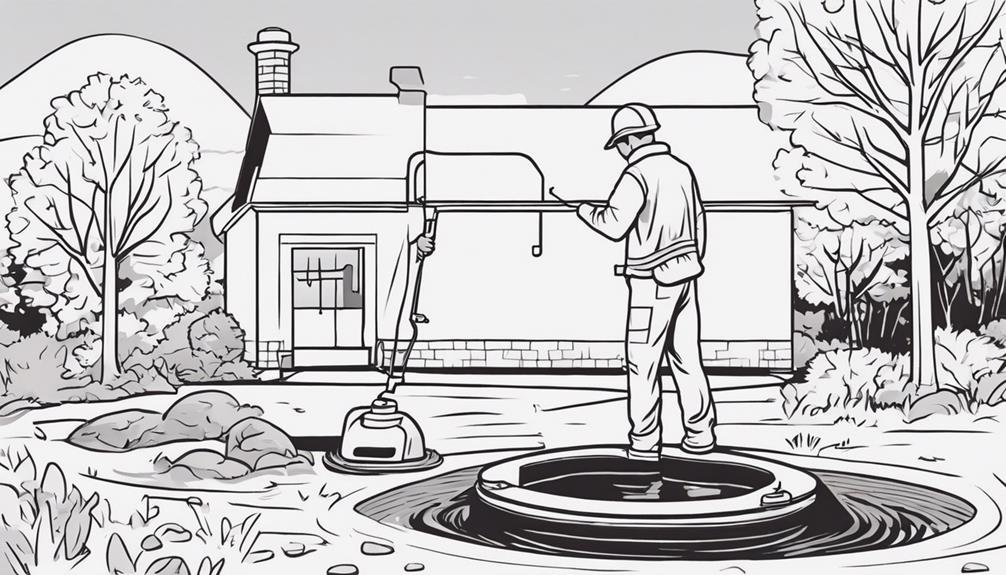Did you know that approximately one-quarter of homes in the United States rely on septic systems for wastewater treatment?
Maintaining your septic tank is crucial for its longevity and preventing costly repairs.
From simple tasks like regular inspections to more complex measures such as managing grease buildup, there are numerous DIY care tips you can implement to ensure your septic system functions smoothly.
By following these strategies, you can safeguard your property and avoid potential headaches down the line.
Key Takeaways
- Regularly inspect and maintain the septic system according to seasonal schedules.
- Practice proper waste management to reduce solid waste and chemicals in the tank.
- Handle grease and chemicals cautiously to prevent backups and costly repairs.
- Maintain the drainfield by aerating soil, preventing root intrusion, and avoiding heavy vehicles.
Seasonal Septic Tank Inspection

When conducting a seasonal septic tank inspection, ensure to thoroughly examine all components for signs of wear or damage. Start with a Winter protection check to safeguard your septic system from freezing temperatures. Verify that the tank is properly insulated and cover exposed pipes to prevent them from freezing.
In Spring, perform a comprehensive checkup to assess any potential damage caused by the harsh winter conditions. Look for leaks, cracks, or any signs of deterioration in the tank and drainage field.
Summer maintenance is crucial to keep your septic tank running smoothly. Inspect the system for any signs of overloading or blockages.
Proper Waste Disposal Practices
To maintain the optimal functioning of your septic system, it's crucial to implement proper waste disposal practices that minimize the risk of damage and ensure efficient operation. Proper waste disposal not only helps in prolonging the lifespan of your septic tank but also contributes to environmental sustainability.
Here are some essential waste disposal practices you should follow:
- Waste Reduction Strategies: Minimize the amount of solid waste and chemicals that enter your septic system by being mindful of what you flush down the drains. Avoid disposing of items like paper towels, hygiene products, grease, and harsh chemicals.
- DIY Maintenance: Regularly pump your septic tank and schedule professional inspections to prevent any potential issues. Implementing a routine maintenance schedule can significantly reduce the chances of costly repairs in the future.
- Eco-Friendly Disposal Methods: Consider adopting eco-friendly disposal methods such as backyard composting for organic waste. Composting not only reduces the load on your septic system but also provides nutrient-rich soil for your garden.
Effective Grease and Chemical Management

Effective management of grease and chemicals is essential for ensuring the longevity and efficiency of your septic system. Grease buildup can clog your system, leading to backups and costly repairs. To prevent this, avoid pouring grease down the drain. Instead, collect it in a container and dispose of it in the trash.
Additionally, opt for chemical alternatives when cleaning your home. Harsh chemicals can disrupt the natural balance of bacteria in your septic tank, reducing its effectiveness. Look for septic-safe cleaning products that are labeled as such. These products are designed to break down waste without harming your system.
Regularly maintaining your septic system by managing grease and chemicals will help prevent issues and extend the life of your system. By being mindful of what goes down the drain, you can keep your septic system running smoothly for years to come.
Drainfield Maintenance Techniques
Proper maintenance of your septic system's drainfield is crucial for ensuring its optimal performance and longevity. To keep your drainfield in top condition, follow these essential maintenance techniques:
- Regular Soil Aeration: Over time, the soil in the drainfield can become compacted, hindering proper drainage. To prevent this issue, consider aerating the soil in the drainfield area. Aeration helps improve soil structure, allowing for better water flow and oxygen exchange, which are vital for the health of your drainfield.
- Monitor and Prevent Root Intrusion: Tree roots can cause significant damage to your drainfield by clogging pipes and disrupting the soil. Regularly inspect the area around your drainfield for any signs of root intrusion. Consider planting trees and shrubs away from the drainfield area to prevent roots from causing harm.
- Avoid Heavy Traffic: Keep heavy vehicles and machinery off the drainfield area. Excessive weight can compact the soil, leading to drainage issues. By minimizing traffic on the drainfield, you can help preserve its functionality and prevent damage.
Emergency Troubleshooting Tips

Maintaining a healthy drainfield is crucial, but in case of emergencies, knowing effective troubleshooting tips can help you address issues promptly and prevent further damage to your septic system. If you suspect septic tank leaks, a sudden increase in your water bill, soggy patches in your yard, or sewage backup are telltale signs. Act quickly by contacting a professional to assess and repair any leaks to avoid contamination of the surrounding area.
Foul odors emanating from your septic system can indicate a problem. Check for clogs in your plumbing, ensure all drains have water traps to prevent sewer gas from escaping, and inspect the vent pipe on your roof for blockages. Regularly pumping your septic tank can also help prevent foul odors by maintaining proper waste breakdown.
Frequently Asked Questions
Can I Use Homemade or Natural Remedies to Maintain My Septic Tank?
You can absolutely use homemade or natural remedies to maintain your septic tank. DIY septic tank additives like baking soda, vinegar, or even yogurt can help maintain healthy bacteria levels. Natural septic maintenance is cost-effective and eco-friendly.
How Often Should I Have My Septic Tank Pumped?
You should aim to have your septic tank pumped every 3-5 years. Regular pumping prevents costly repairs and helps the environment. Consider eco-friendly alternatives like enzyme treatments to maintain your tank efficiently and sustainably.
Are There Any Specific Plants or Landscaping Features That Can Help Protect My Septic System?
When it comes to protecting your septic system, incorporating eco-friendly landscaping and strategic plant selection can make a big difference. Certain plants can help absorb excess moisture and prevent soil erosion, ultimately benefiting your septic tank's longevity.
Can I Add Enzymes or Bacteria Supplements to My Septic Tank to Improve Its Performance?
Feeling unsure about enzyme effectiveness or bacteria balance in your septic tank? DIY dosing with treatment options can be beneficial. Adding supplements when needed helps maintain a healthy system, ensuring optimal performance and longevity.
What Are Some Signs That My Septic Tank May Be Failing, and How Can I Address These Issues Before They Become Emergencies?
If you notice septic tank odors or early warning signs of failure, like slow drains or soggy areas, schedule an inspection promptly. Prevent emergencies by addressing issues early through regular maintenance and proper care.
Conclusion
So there you have it – by following these DIY septic tank care tips, you can ensure your system stays in top shape and avoids costly repairs.
Did you know that a typical household septic tank should be pumped every 3-5 years to prevent buildup and maintain proper function?
By taking care of your septic system with these tips, you can save money in the long run and avoid any messy situations.
Happy DIY-ing!

